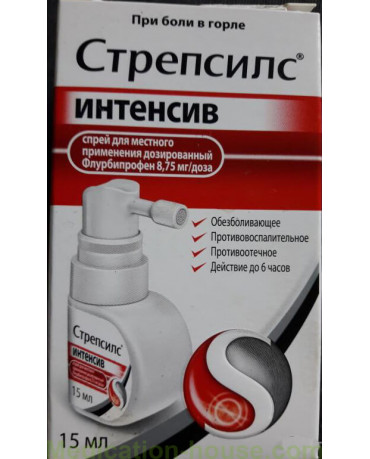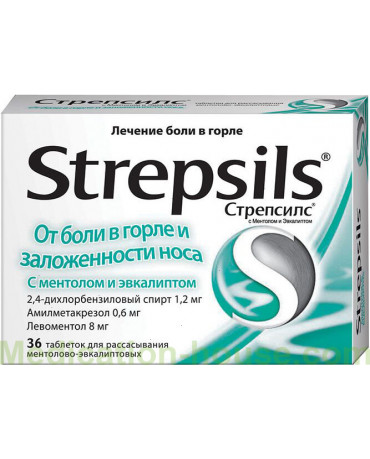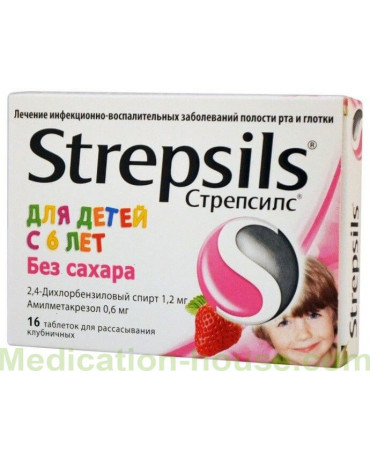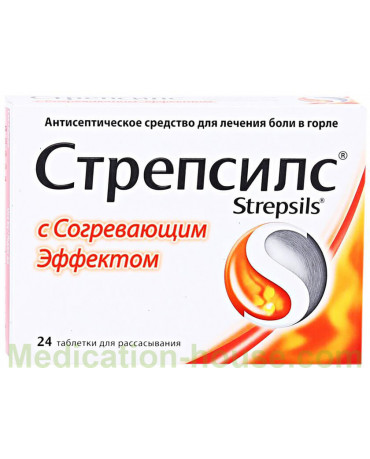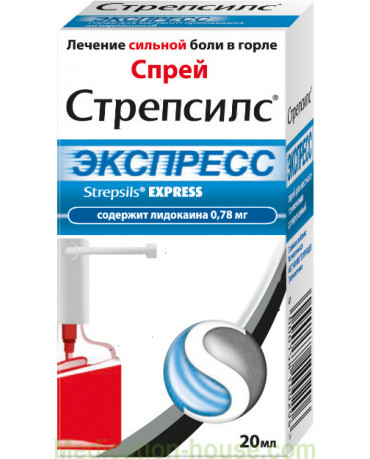Strepsils Intensive instruction
You can buy Strepsils Intensive here
Structure
One resorption tablet contains
active substance: flurbiprofen 8.75 mg,
Excipients:
lozenges [honey-lemon]: macrogol 300 5.47 mg, potassium hydroxide 2.19 mg, liquid sucrose 1407 mg, levomenthol 2 mg, dextrose 1069 mg, honey 50.4 mg, lemon flavor (502904 A) 3, 6 mg
lozenges [orange]: macrogol 300 5.47 mg, potassium hydroxide 2.19 mg, orange flavor PHL-010300 10 mg, levomenthol 2 mg, acesulfame potassium 3 mg, isomalt 2033.29 mg, maltitol liquid 509.31 mg .
Description
Lozenges [honey-lemon]: round tablets of translucent caramel mass from light yellow to light brown in color, with the letter S on the 2 sides of the tablet. The presence of air bubbles in the caramel mass and slight unevenness of the edges are allowed. White plaque may appear.
Absorption tablets [orange]: round tablets of translucent caramel mass from white to light yellow in color, with the letter S on 2 sides of the tablet. The presence of air bubbles in the caramel mass and slight unevenness of the edges are allowed. White plaque may appear.
Pharmacodynamics
Flurbiprofen is a derivative of propionic acid from the group of non-steroidal anti-inflammatory drugs (NSAIDs) and has a significant analgesic, anti-inflammatory and antipyretic effect due to the suppression of cyclooxygenase-1 (COX-1) and cyclooxygenase-2 (COX-2), with some selectivity with respect to -1, resulting in a decrease in the production of prostaglandins - mediators of pain, inflammation and hyperthermia.
Strepsils Intensive has a local analgesic and anti-inflammatory effect on the mucous membrane of the oral cavity and throat: it reduces swelling, difficulty swallowing, pain and a feeling of irritation in the throat.
The tablet is completely dissolved in the oral cavity within 5-12 minutes. The calming effect begins from the 2nd minute.
A significant decrease in the intensity of sore throat begins from 22 minutes with the achievement of the maximum effect after 70 minutes and lasts up to 4 hours.
Pharmacokinetics
The tablet is completely dissolved in the oral cavity within 5-12 minutes. Absorption is high, flurbiprofen is rapidly and almost completely absorbed, distributed throughout the body and is largely associated with plasma proteins. Flurbiprofen is detected in the blood after 5 minutes, the maximum concentration of flurbiprofen in the blood plasma (Cmax) is reached 40–45 minutes after resorption.
Flurbiprofen can be absorbed into the oral cavity by passive diffusion. The absorption rate depends on the dosage form, with resorption, the maximum concentration of flurbiprofen is achieved faster than when ingested an equivalent dose of flurbiprofen.
The half-life (T1 / 2) is 3-6 hours. It is metabolized in the liver by hydroxylation and excreted by the kidneys and, to a lesser extent, with bile. Flurbiprofen is excreted in breast milk in small amounts (<0.05 μg / ml). Approximately 20–25% of an oral dose of flurbiprofen is excreted unchanged.
Indications for use
As a symptomatic agent to relieve sore throat with infectious and inflammatory diseases of the oral cavity and pharynx.
Contraindications
Hypersensitivity to flurbiprofen or any of the components that make up Strepsils Intensive.
The presence of a history of hypersensitivity reactions (bronchial asthma, bronchospasm, rhinitis, Quincke edema, urticaria, recurrent polyposis of the nose or paranasal sinuses) in response to the use of acetylsalicylic acid or other NSAIDs.
Erosive and ulcerative diseases of the gastrointestinal tract (including gastric and duodenal ulcer, Crohn's disease, ulcerative colitis) or ulcer bleeding in the exacerbation phase or in the anamnesis (two or more confirmed episodes of peptic ulcer or ulcer bleeding).
A history of bleeding or perforation of an ulcer of the gastrointestinal tract, provoked by the use of NSAIDs.
Deficiency of glucose-6-phosphate dehydrogenase, hemophilia and other bleeding disorders (including hypocoagulation), hemorrhagic diathesis.
Severe liver failure or liver disease in the active phase.
Severe renal failure (creatinine clearance <30 ml / min), confirmed hyperkalemia.
Decompensated heart failure; the period after coronary artery bypass grafting.
Sucrose / isomaltase deficiency, fructose intolerance, glucose-galactose malabsorption.
Pregnancy (III trimester).
Children's age up to 12 years.
Carefully
In the presence of the conditions specified in this section, before using Strepsils Intensive, consult your doctor.
Simultaneous administration of other NSAIDs; the presence in the history of a single episode of gastric ulcer or gastrointestinal ulcer; a history of a gastrointestinal tract (ulcerative colitis, Crohn's disease), gastritis, enteritis, colitis, the presence of Helicobacter pylori infection; bronchial asthma or allergic diseases in the acute stage or in the anamnesis - the development of bronchospasm is possible; systemic lupus erythematosus or mixed connective tissue disease (Sharp syndrome) - the risk of aseptic meningitis is increased (with short-term use of flurbiprofen, the risk is negligible); renal failure, including during dehydration (creatinine clearance less than 30-60 ml / min), nephrotic syndrome; liver failure, cirrhosis with portal hypertension, hyperbilirubinemia; arterial hypertension and / or heart failure, edema; concomitant use of drugs that may increase the risk of ulcers or bleeding, in particular oral glucocorticosteroids (including prednisone), anticoagulants (including warfarin), antiplatelet agents (including acetylsalicylic acid, clopidogrel), selective serotonin reuptake inhibitors ( including citalopram, fluoxetine, paroxetine, sertraline); pregnancy I-II trimester, the period of breastfeeding; elderly age; alcohol consumption.
Use during pregnancy and during breastfeeding
The use of Strepsils Intensive in the third trimester of pregnancy is contraindicated. The use of flurbiprofen in the I-II trimesters of pregnancy should be avoided, if necessary, the use of Strepsils Intensive should consult a doctor.
There is evidence that flurbiprofen in small amounts can pass into breast milk without any negative consequences for the health of the infant, however, due to possible side effects of NSAIDs, the use of Strepsils Intensive during breastfeeding is not recommended.
Dosage and administration
Read the instructions carefully before using Strepsils Intensive.
For topical use. For short-term use only.
Adults and children over 12 years of age: slowly dissolve 1 tablet every 3-6 hours.
Maximum daily dose: 5 tablets in 24 hours.
Duration of therapy: no more than 3 days.
If, after taking Strepsils Intensive for 3 days, the symptoms persist or intensify, it is necessary to stop treatment and consult a doctor.
Side effect of Strepsils Intensive
The risk of side effects can be minimized if you take Strepsils Intensive in a short course at the minimum effective dose necessary to eliminate the symptoms.
The following adverse reactions were noted with short-term use of Strepsils Intensive. In the treatment of chronic conditions and with prolonged use, other adverse reactions may occur.
The frequency of adverse reactions was estimated based on the following criteria: very often (≥ 1/10), often (from ≥ 1/100 to <1/10), infrequently (from ≥ 1/1000 to <1/100), rarely ( from ≥ 1/10 000 to <1/1000), very rarely (<1/10 000), the frequency is unknown (data on frequency estimation are not available).
Disorders from the blood and lymphatic system
Frequency unknown: hematopoiesis (anemia, thrombocytopenia).
Disorders of the nervous system
Often: dizziness, headache, paresthesia.
Infrequently: drowsiness.
Immune System Disorders
Rarely: anaphylactic reactions.
Heart disorders
Frequency unknown: heart failure, edema.
Vascular disorders
Frequency unknown: increased blood pressure.
Disorders of the respiratory system, chest and mediastinal organs
Often: a sore throat.
Infrequently: exacerbation of asthma and bronchospasm, shortness of breath, wheezing, blisters in the mouth and pharynx, pharyngeal hypesthesia (decreased sensitivity in the mouth and pharynx).
Gastrointestinal Disorders
Often: diarrhea, ulceration of the oral cavity, nausea, pain in the oral cavity, paresthesia of the oral cavity, pain in the oral cavity and pharynx, discomfort in the oral cavity (feeling of heat, burning sensation or tingling in the mouth).
Infrequently: bloating, abdominal pain, constipation, dry mouth, dyspepsia, flatulence, glossalgia (burning mouth syndrome), dysgeusia (change in taste perception), oral dysesthesia, vomiting.
Disorders of the skin and subcutaneous tissue
Uncommon: skin rash, itching.
Frequency unknown: Severe skin reactions such as bullous reactions, including Stevens-Johnson syndrome and toxic epidermal necrolysis (Lyell's syndrome).
Violations of the liver and biliary tract
Frequency unknown: hepatitis.
Mental disorders
Infrequently: insomnia.
Other
Infrequently: fever, pain.
Overdose
Symptoms: nausea, vomiting, epigastric pain or, less commonly, diarrhea, tinnitus, headache and gastrointestinal bleeding. In more severe cases, manifestations from the central nervous system are observed: drowsiness, rarely - agitation, convulsions, disorientation, coma. In cases of severe poisoning, metabolic acidosis and an increase in prothrombin time, acute renal failure, damage to liver tissue, decreased blood pressure, respiratory depression and cyanosis can develop. In patients with bronchial asthma, an exacerbation of this disease is possible.
Treatment: symptomatic, with mandatory airway management, ECG monitoring and basic vital signs up to the normalization of the patient's condition. Oral administration of activated charcoal or gastric lavage within one hour after taking a potentially toxic dose of flurbiprofen is recommended. Frequent or prolonged seizures should be stopped by the intravenous administration of diazepam or lorazepam. With exacerbation of bronchial asthma, the use of bronchodilators is recommended. There is no specific antidote to flurbiprofen.
Interaction with other drugs
The simultaneous use of flurbiprofen with the following drugs should be avoided:
Acetylsalicylic acid: with the exception of low doses of acetylsalicylic acid (not more than 75 mg per day), prescribed by a doctor, since combined use may increase the risk of side effects.
Other NSAIDs, including ibuprofen and selective cyclooxygenase-2 inhibitors: the simultaneous use of two or more drugs from the NSAID group should be avoided because of the possible increased risk of side effects.
Use with caution simultaneously with the following drugs:
Anticoagulants: NSAIDs may enhance the effect of anticoagulants, in particular warfarin.
Antiplatelet agents and selective serotonin reuptake inhibitors: increased risk of gastrointestinal bleeding.
Antihypertensive drugs (ACE inhibitors and angiotensin II antagonists) and diuretics: NSAIDs may decrease the effectiveness of drugs of these groups and may increase nephrotoxicity due to inhibition of cyclooxygenase, especially in patients with impaired renal function (it is necessary to ensure adequate fluid compensation in such patients).
Alcohol: there may be an increased risk of adverse reactions, especially bleeding in the gastrointestinal tract.
Cardiac glycosides: the simultaneous use of NSAIDs and cardiac glycosides can lead to aggravation of heart failure, a decrease in glomerular filtration rate and an increase in the concentration of cardiac glycosides in blood plasma.
Cyclosporine: increased risk of nephrotoxicity while the use of NSAIDs and cyclosporine.
Glucocorticosteroids: increased risk of ulceration of the gastrointestinal tract and gastrointestinal bleeding.
Lithium preparations: there is evidence of the likelihood of an increase in the concentration of lithium in blood plasma during the use of NSAIDs.
Methotrexate: there is evidence of a likelihood of increasing the concentration of methotrexate in blood plasma during the use of NSAIDs. It is necessary to take NSAIDs 24 hours before or after taking methotrexate.
Mifepristone: NSAIDs should be started no earlier than 8-12 days after the end of the use of mifepristone, since NSAIDs can reduce the effectiveness of mifepristone.
Quinolone series antibiotics: in patients receiving joint treatment with NSAIDs and the quinolone series antibiotics, an increased risk of seizures is possible.
Tacrolimus: with the simultaneous use of NSAIDs and tacrolimus, an increased risk of nephrotoxicity is possible.
Zidovudine: concomitant use of NSAIDs and zidovudine may lead to increased hematotoxicity.
Oral hypoglycemic drugs: a change in blood glucose levels is possible (it is recommended to increase the frequency of monitoring blood glucose levels).
Phenytoin: an increase in serum phenytoin levels is possible (monitoring of serum phenytoin levels and, if necessary, dose adjustment is recommended).
Potassium-sparing diuretics: the combined use of potassium-sparing diuretics and flurbiprofen can lead to hyperkalemia.
Probenecid and sulfinpyrazone: Medicines containing probenecid or sulfinpyrazone may delay flurbiprofen excretion.
Tolbutamide and antacids: to date, studies have not revealed interactions between flurbiprofen and tolbutamide or antacids.
Special instructions
It is recommended to take Strepsils Intensive as short as possible and in the minimum effective dose necessary to eliminate the symptoms.
Patients with diabetes should take into account that each honey-lemon resorption tablet contains about 2.5 g of sugar (0.21 XE) (orange resorption tablets do not contain sugar).
Orange resorption tablets in the composition contain liquid maltitol and isomalt (the maximum daily dose of which exceeds 2 g), therefore, they may have a laxative effect.
When symptoms of gastropathy appear, careful monitoring is indicated, including esophagogastroduodenoscopy, a general blood test (determination of hemoglobin), fecal occult blood analysis.
If it is necessary to determine 17-ketosteroids, Strepsils Intensive should be discontinued 48 hours before the study.
During treatment, ethanol is not recommended.
Patients with renal or hepatic insufficiency, as well as elderly patients and patients taking diuretics, should consult a doctor before using Strepsils Intensive, since there is a risk of impaired renal function. With short-term use of the drug, the risk is negligible.
Patients with arterial hypertension, including a history of and / or chronic heart failure, should consult a doctor before using Strepsils Intensive, since the drug can cause fluid retention, increased blood pressure and swelling.
Information for women planning a pregnancy: Strepsils Intensive suppresses cyclooxygenase and prostaglandin synthesis and can affect ovulation, disrupting female reproductive function (reversible after discontinuation of treatment).
If there is irritation in the oral cavity, skin rash, damage to the mucous membrane and other manifestations of an allergic reaction, you should stop using Strepsils Intensive and consult a doctor.
In case of worsening of existing symptoms or the appearance of new ones, including the appearance of signs of a bacterial infection, it is necessary to immediately consult a doctor to review therapy.
Influence on the ability to drive vehicles, mechanisms
Patients reporting dizziness, drowsiness, lethargy, or visual impairment while taking flurbiprofen should avoid driving vehicles or operating machinery.
Release form
Lozenges [honey-lemon], lozenges [orange], 8.75 mg.
For 4, 6, 8, 10 or 12 tablets in a blister pack (PVC / PVDC / Aluminum). 1, 2, 3, 4 or 5 blisters are placed in a cardboard box along with instructions for use.
Storage conditions
Store at a temperature not exceeding 25 ° C.
Keep out of the reach of children.
Shelf life
Lozenges [honey-lemon]: 3 years.
Lozenges [orange]: 2 years.
Do not use an expired drug.
Terms of sell
You don't need a prescription to buy Strepsils Intensive.


